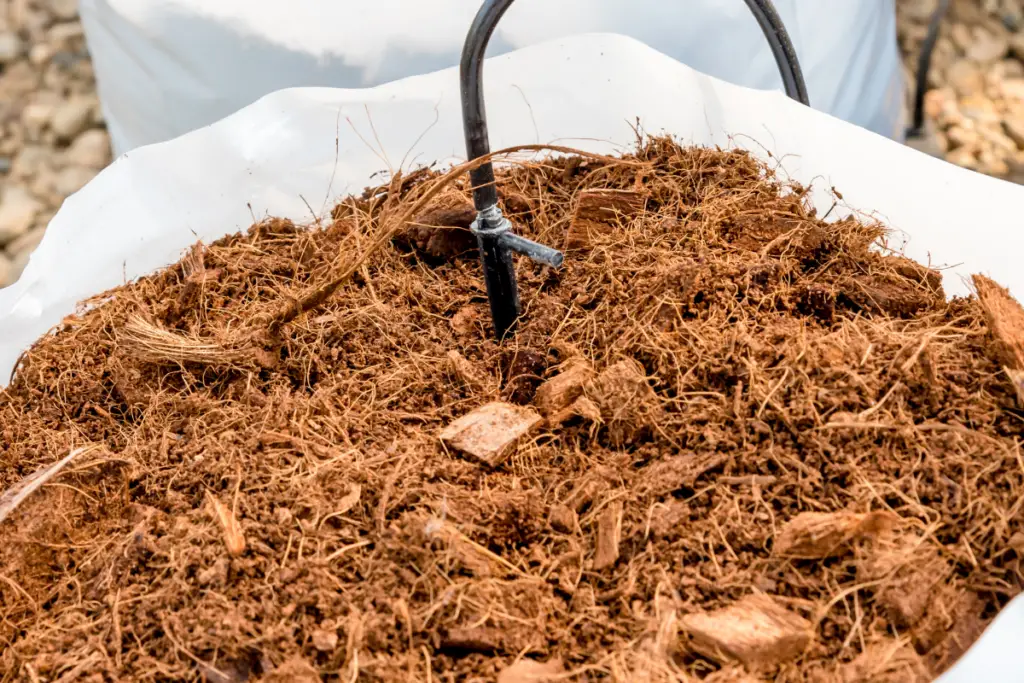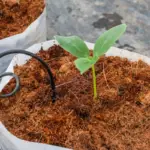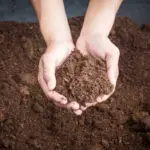Peat soil is a type of soil that is composed of decomposed organic matter, such as sphagnum moss, that has accumulated over thousands of years.
This type of soil is known for its unique properties, which make it ideal for growing certain types of crops.
Peat soil is naturally acidic and has a low nutrient content, but it is also able to retain water well, making it an excellent choice for crops that require moist conditions.
There are several crops that are known to grow well in peat soil. These include blueberries, cranberries, and lingonberries, which are all acidic fruits that thrive in the low pH environment provided by peat soil.
Other crops that can be grown in peat soil include potatoes, carrots, and onions, which are all root vegetables that benefit from the soil’s ability to retain moisture.
While peat soil can be a great choice for certain crops, it is important to note that it is not suitable for all types of plants, and farmers should carefully consider their options before deciding to grow crops in peat soil.

Table of Contents
Understanding Peat Soil
Peat soil is a type of soil that is formed by the accumulation of partially decayed plant material under waterlogged conditions.
It is a unique type of soil that has some specific characteristics and properties that make it different from other types of soil.
Peat soil is usually found in cool, wet, and swampy areas where the water table is high. It is usually dark brown or black in color, and it has a spongy texture.
Peat soil is also highly acidic, with a pH value that can range from 3.5 to 5.5.
Peat soil has some unique properties that make it suitable for growing certain types of crops. For example, it has a high water-holding capacity, which means that it can retain water for a long time.
This makes it ideal for growing crops that require a lot of moisture, such as cranberries, blueberries, and other berries.
Peat soil is also rich in organic matter, which makes it an excellent soil amendment for improving the fertility of other types of soil.
It is also a good source of nutrients, such as nitrogen, phosphorus, and potassium.
However, peat soil also has some drawbacks. One of the main drawbacks is that it is highly susceptible to compaction, which can reduce its water-holding capacity and make it difficult for crops to grow.
In addition, peat soil can be difficult to work with because of its spongy texture, which can make it hard to plant and harvest crops.
Types of Crops Grown in Peat Soil
Peat soil is a type of soil that is rich in organic matter and is acidic in nature. It is commonly used for growing crops that require moist soil conditions.
In this section, we will discuss the types of crops that are commonly grown in peat soil.
Root Vegetables
Root vegetables are crops that are grown for their edible roots. They are well-suited for peat soil due to its high moisture content.
Some common root vegetables that are grown in peat soil include:
- Potatoes
- Carrots
- Radishes
- Turnips
These crops thrive in the acidic conditions of peat soil and require regular watering to maintain moisture levels.
Leafy Greens
Leafy greens are crops that are grown for their edible leaves. They are also well-suited for peat soil due to its high moisture content.
Some common leafy greens that are grown in peat soil include:
- Lettuce
- Spinach
- Kale
- Swiss chard
These crops require frequent watering to maintain moisture levels and can be grown in both sunny and shaded areas.
Berries
Berries are fruits that are grown on bushes and vines. They are also well-suited for peat soil due to its high moisture content.
Some common berries that are grown in peat soil include:
- Blueberries
- Cranberries
- Raspberries
- Blackberries
These crops require regular watering to maintain moisture levels and can be grown in both sunny and shaded areas.
Benefits of Growing Crops in Peat Soil
Peat soil is a unique type of soil that is rich in organic matter and is formed by the accumulation of dead plant material in wetland areas.
Despite being acidic and low in nutrients, peat soil has several benefits for growing crops.
In this section, we will discuss some of the benefits of growing crops in peat soil.
1. High Water-Holding Capacity
Peat soil has a high water-holding capacity, which means it can retain water for longer periods compared to other types of soil.
This is because peat soil is composed of organic matter, which can absorb and hold water like a sponge.
This property of peat soil is beneficial for crops as it ensures a steady supply of water to the plants, even during dry periods.
2. Excellent Drainage
Peat soil has excellent drainage properties due to its porous nature. It allows excess water to drain away quickly, preventing waterlogging and root rot in crops.
This property is especially useful in areas with high rainfall, where other types of soil may become waterlogged and unsuitable for growing crops.
3. Reduced Need for Fertilizers
Peat soil is naturally acidic and low in nutrients, but it contains a high level of organic matter.
This organic matter slowly decomposes over time, releasing nutrients such as nitrogen, phosphorus, and potassium that are essential for plant growth.
This means that crops grown in peat soil require less fertilizer compared to crops grown in other types of soil.
4. Increased Soil Microbial Activity
Peat soil is a rich source of organic matter, which provides an ideal habitat for soil microorganisms such as bacteria, fungi, and protozoa.
These microorganisms play a vital role in soil health by decomposing organic matter, releasing nutrients, and improving soil structure.
Increased microbial activity in peat soil can lead to healthier and more productive crops.
In conclusion, peat soil has several benefits for growing crops, including high water-holding capacity, excellent drainage, reduced need for fertilizers, and increased soil microbial activity.
These properties make peat soil an excellent choice for farmers who want to grow crops in wetland areas or areas with high rainfall.
- 🌴【Coco Coir Brick】: Made of 100% natural organic coconut coir, which extracted from the husk on the outer shell of a coconut, low EC and suitable pH can provide a healthy growing environment for most flowers and plants, so it can cultivate flowers and economical plant products without soil, and can also cultivate seedlings
Prices pulled from the Amazon Product Advertising API on:
Product prices and availability are accurate as of the date/time indicated and are subject to change. Any price and availability information displayed on [relevant Amazon Site(s), as applicable] at the time of purchase will apply to the purchase of this product.
Challenges of Growing Crops in Peat Soil
Peat soil is a unique type of soil that presents several challenges to farmers who want to grow crops in it.
Peat soil is characterized by high water tables, low fertility, high acidity, and low bearing capacity, among other features.
These characteristics make it difficult for farmers to grow crops in peat soil. Here are some of the challenges that farmers face when growing crops in peat soil.
Drainage
Peat soil has a high water table, which means that it is often saturated with water.
This makes it difficult for farmers to grow crops in peat soil because excess water can cause the roots of the plants to rot.
To overcome this challenge, farmers need to ensure that the peat soil is well-drained.
They can do this by installing drainage systems, such as ditches and tile drains, that will help to remove excess water from the soil.
Low Fertility
Peat soil is naturally low in nutrients, which makes it difficult for crops to grow.
To overcome this challenge, farmers need to add fertilizers to the soil. However, adding too much fertilizer can lead to environmental problems, such as eutrophication, which can harm aquatic life.
Therefore, farmers need to apply fertilizers carefully and in the right amounts to ensure that they do not harm the environment.
High Acidity
Peat soil is naturally acidic, which can make it difficult for crops to grow. To overcome this challenge, farmers need to add lime to the soil to neutralize the acidity.
However, adding too much lime can also harm the environment, so farmers need to apply lime carefully and in the right amounts.
Subsidence
Peat soil is prone to subsidence, which means that it can sink over time. This can make it difficult for farmers to grow crops in peat soil because the sinking soil can cause damage to the crops.
To overcome this challenge, farmers need to ensure that the peat soil is stable. They can do this by avoiding activities that can cause the soil to sink, such as heavy machinery and drainage.
Peat Soil Management for Crop Cultivation
Peat soil is a unique type of soil that has a high organic matter content.
It is often used for crop cultivation due to its high water-holding capacity and nutrient content. However, improper management of peat soil can lead to soil degradation and loss of productivity.
Therefore, it is essential to adopt proper management practices for successful crop production in peat soil.
Soil Preparation
Proper soil preparation is crucial for successful crop production in peat soil.
The following practices can help prepare the soil for cultivation:
- Drainage: Peat soil has a high water-holding capacity, which can lead to waterlogging and reduced crop productivity. Therefore, proper drainage is necessary to remove excess water from the soil.
- Liming: Peat soil is naturally acidic, which can affect crop growth. Therefore, liming the soil can help to neutralize the acidity and improve soil fertility.
- Fertility Management: Peat soil has a high nutrient content, but the nutrients are often not available to plants due to the high acidity. Therefore, proper fertility management practices such as the application of organic matter and fertilizers can help to improve soil fertility and nutrient availability.
Crop Management
Proper crop management practices are necessary for successful crop production in peat soil.
The following practices can help to improve crop productivity:
- Water Management: Proper water management is crucial for crop growth in peat soil. Over-irrigation can lead to waterlogging, while under-irrigation can lead to drought stress. Therefore, it is essential to maintain proper soil moisture levels for optimal crop growth.
- Tillage: Proper tillage practices can help to improve soil structure and aeration, which can lead to improved crop growth. However, excessive tillage can lead to soil compaction and degradation.
- Crop Rotation: Crop rotation can help to improve soil fertility and reduce the risk of pest and disease infestation. Therefore, it is essential to adopt proper crop rotation practices for successful crop production in peat soil.
Proper peat soil management practices can help to improve crop productivity and reduce soil degradation.
Therefore, it is essential to adopt these practices for successful crop production in peat soil.
Sustainable Practices in Peat Soil Farming
Peatlands are critical for mitigating the effects of climate change, preserving biodiversity, and ensuring safe drinking water.
However, peat soil farming can have negative impacts on the environment, including the release of greenhouse gases and the destruction of peatlands.
Therefore, it is essential to adopt sustainable practices in peat soil farming to minimize these impacts.
Crop Rotation
Crop rotation is a sustainable practice that involves planting different crops in the same field in a planned sequence.
This practice helps to maintain soil fertility and reduce soil erosion. In peat soil farming, crop rotation can help to reduce the risk of soil degradation and improve crop yields.
For example, farmers can alternate between planting rice and soybeans, which have different nutrient requirements and growth patterns.
Conservation Tillage
Conservation tillage is a practice that involves reducing soil disturbance during planting and cultivation.
This practice helps to preserve soil structure and reduce soil erosion.
In peat soil farming, conservation tillage can help to reduce the risk of soil degradation and improve crop yields. For example, farmers can use no-till or reduced-till methods to plant their crops.
Organic Farming
Organic farming is a sustainable practice that involves using natural fertilizers and pest control methods.
This practice helps to reduce the use of synthetic chemicals and protect the environment. In peat soil farming, organic farming can help to reduce the risk of soil degradation and improve crop yields.
For example, farmers can use compost and manure to fertilize their crops and use natural pest control methods such as crop rotation and companion planting.
Peatland Restoration
Peatland restoration is a sustainable practice that involves restoring degraded peatlands to their natural state.
This practice helps to reduce greenhouse gas emissions and preserve biodiversity.
In peat soil farming, peatland restoration can help to reduce the negative impacts of farming on the environment.
For example, farmers can restore degraded peatlands by blocking drainage canals and planting native vegetation.
Future of Peat Soil in Agriculture
Peat soil is a type of organic soil that is formed from partially decayed plant material.
It is an important agricultural resource, especially in regions with a cool and wet climate.
However, the use of peat soil in agriculture has been a topic of debate due to its environmental impact. Therefore, the future of peat soil in agriculture is uncertain.
Challenges
One of the main challenges in using peat soil in agriculture is its impact on the environment. Peat soil is a non-renewable resource that takes thousands of years to form.
The extraction of peat soil for agricultural purposes can lead to the destruction of natural habitats and the release of carbon dioxide into the atmosphere.
Additionally, the drainage of peat soil can lead to subsidence and flooding.
Solutions
To address the challenges associated with the use of peat soil in agriculture, several solutions have been proposed.
One solution is to reduce the use of peat soil in agriculture and to promote alternative growing media such as coconut coir, perlite, and vermiculite.
Another solution is to develop sustainable peatland management practices that minimize the environmental impact of peat extraction.
This can include the restoration of degraded peatlands and the use of paludiculture, which involves the cultivation of wetland plants for food and fuel.
Conclusion
The future of peat soil in agriculture depends on the adoption of sustainable practices that minimize its environmental impact.
While peat soil remains an important agricultural resource, its use must be balanced with the need to protect natural habitats and reduce greenhouse gas emissions.
The development of alternative growing media and sustainable peatland management practices can help to ensure the long-term viability of agriculture in peat soil regions.
- How to Dry Basil Leaves: A Professional Guide
- Is an Avocado a Fruit or Vegetable? Simple Answer and Explanation
- Does Pineapple Have Seeds? Exploring the Anatomy of Pineapples
- Blooming Through Winter: Can I Grow Vegetables Indoors in the Winter?
- What Can You Grow in a Greenhouse All Year Round: A Guide to Year-Round Greenhouse Gardening
- Are Blueberries Blue? Debunking the Myth of Their Color

















